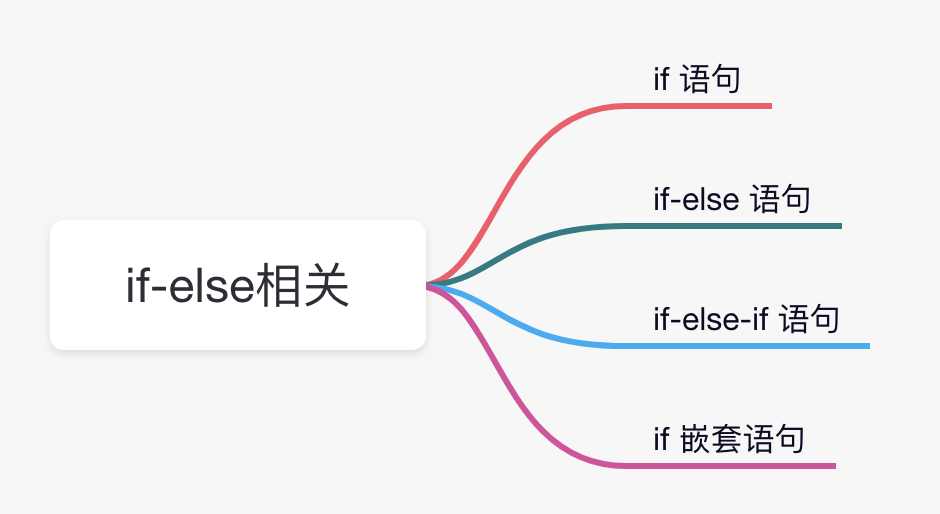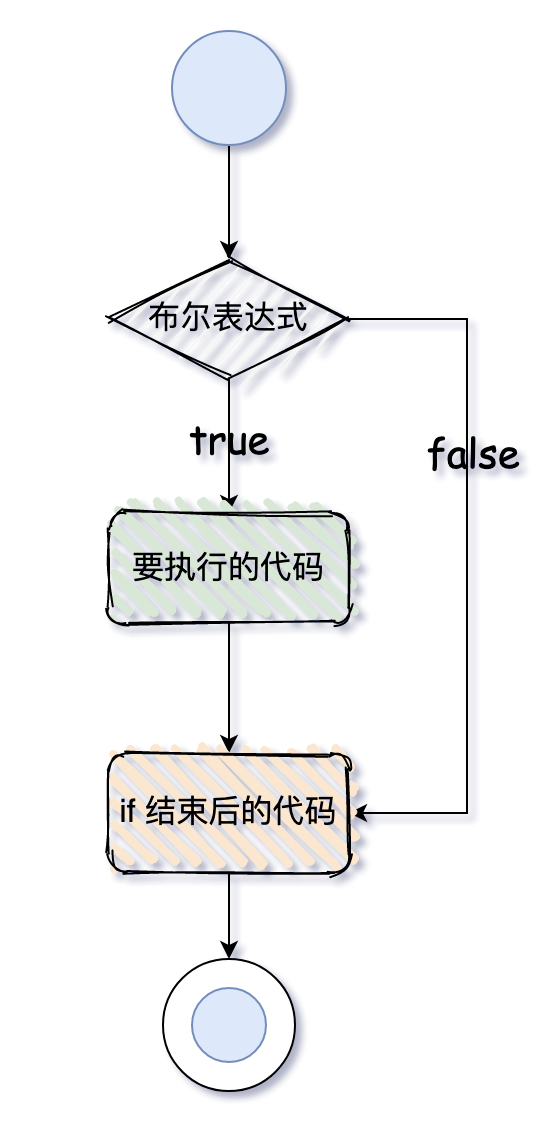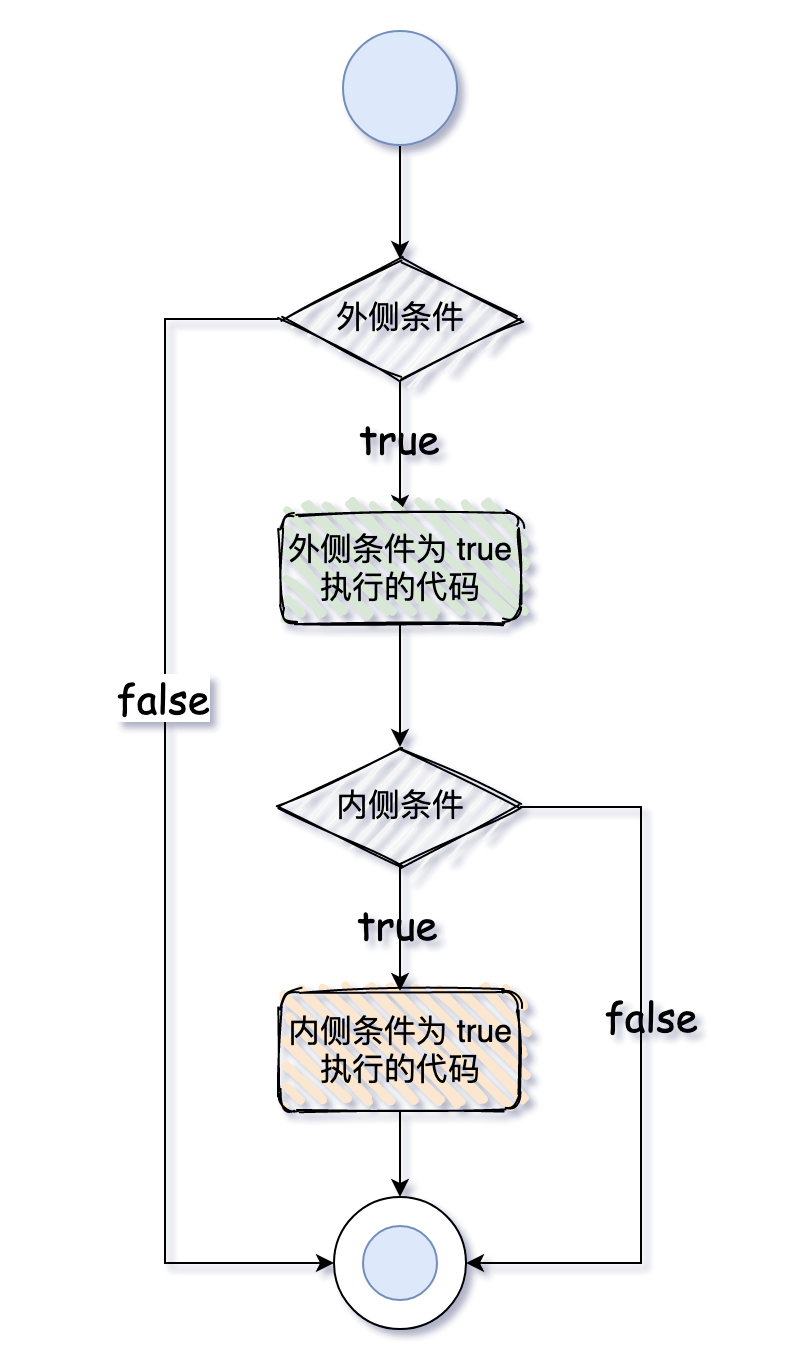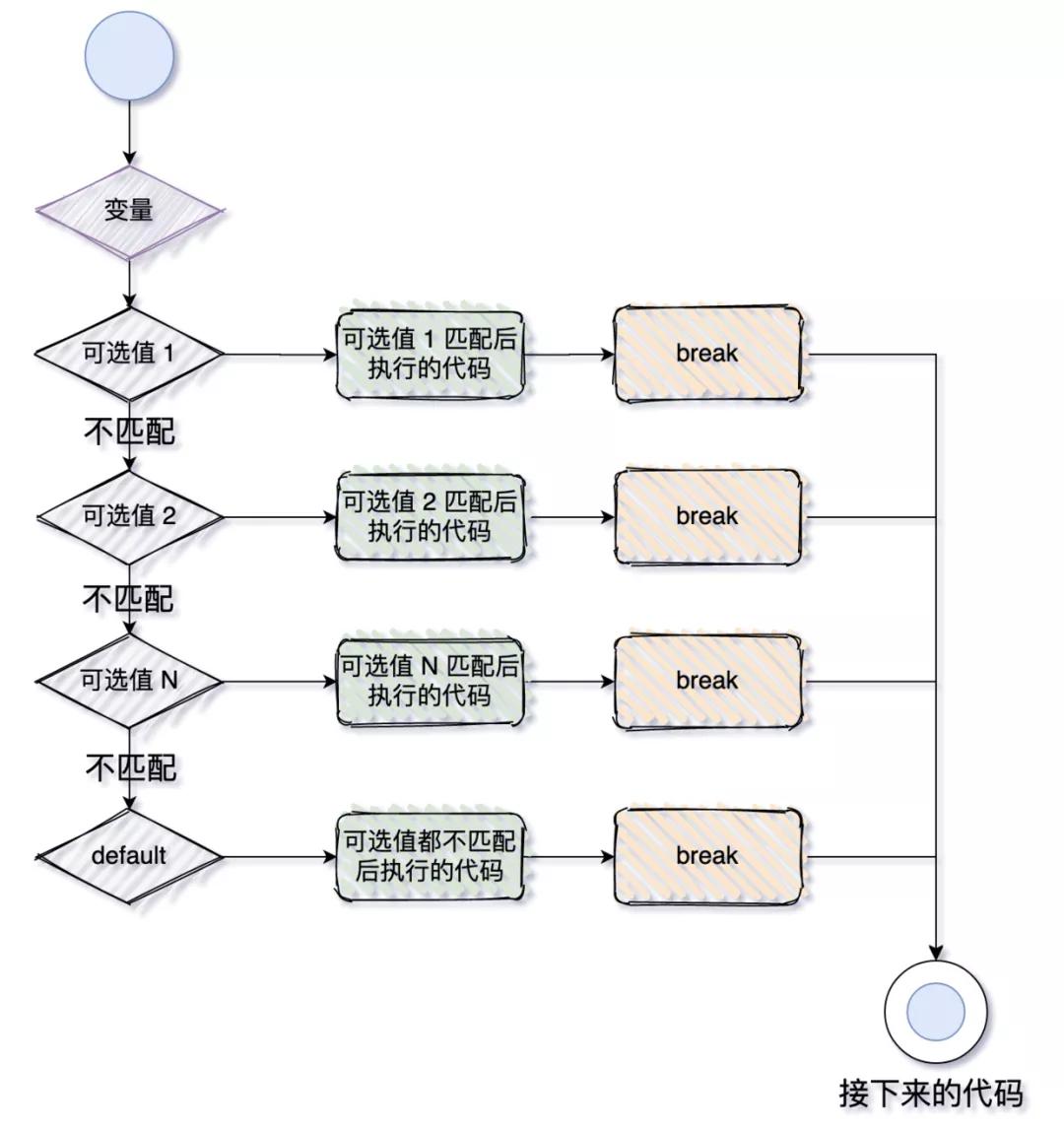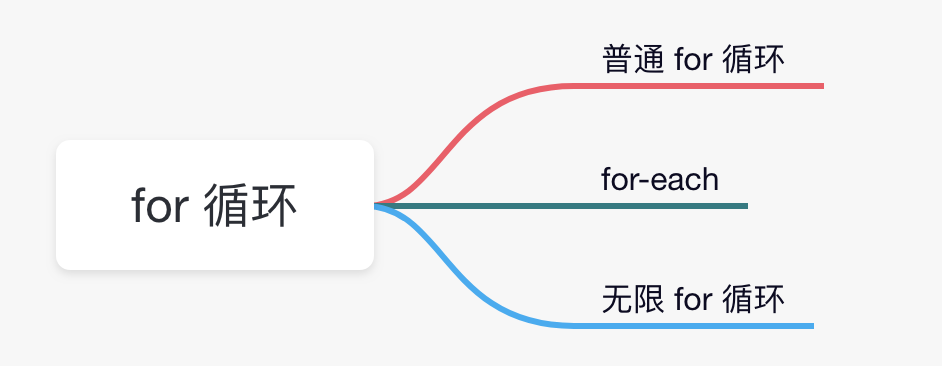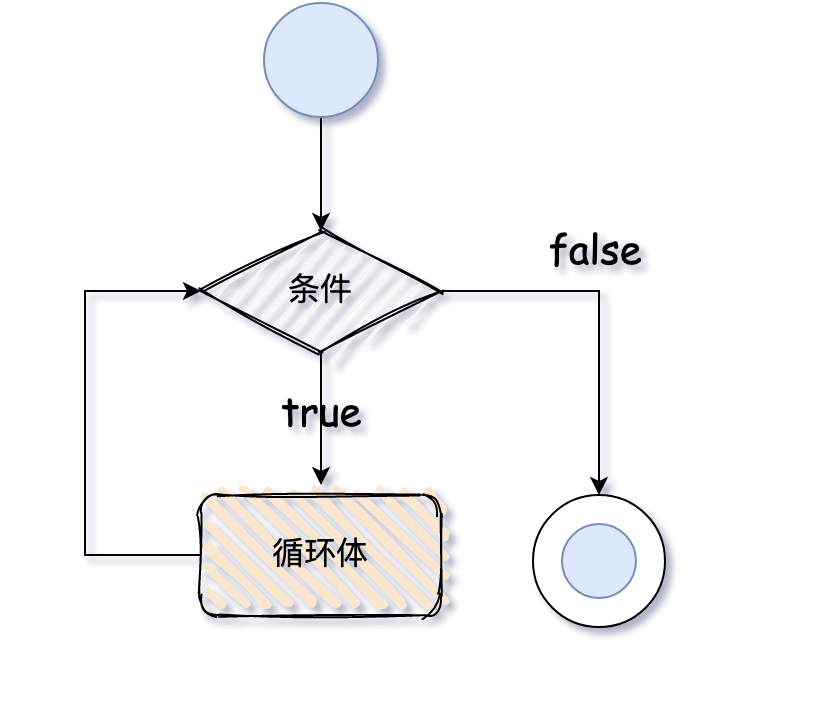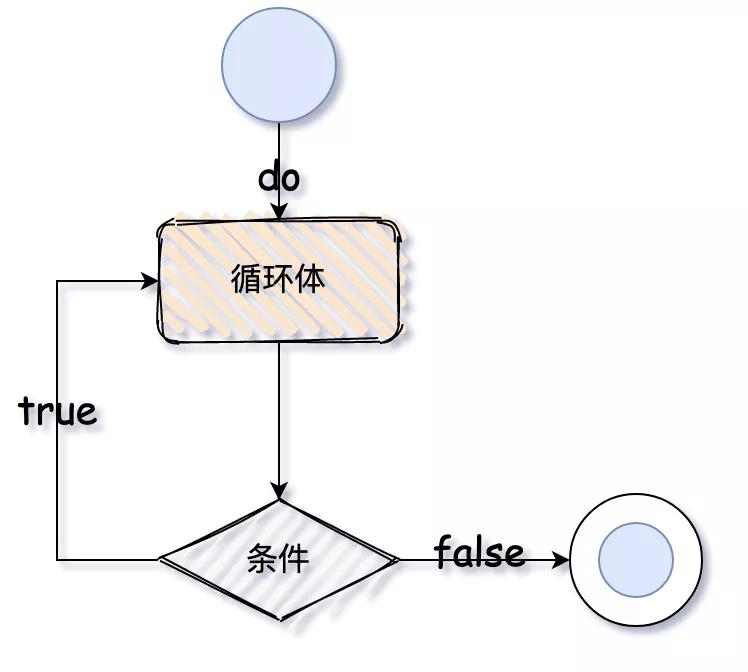同学们好啊,我是沉默王二,一枚沉默但有趣又帅气的程序员(听,是不是一种二哥卖瓜的赶脚)。又到了《教妹学 Java》的时间,很开心,很期待,很舒适。这是《教妹学 Java》专栏的第 13 篇文章,我们来谈谈“Java 中的流程控制语句”。
强调一下,《教妹学 Java》面向的是零基础的 Java 爱好者,我希望能帮助同学们轻松迈进编程世界的大门,为后续的深入学习打下坚实的基础。
“二哥,流程控制语句都有哪些呢?”三妹的脸上泛着甜甜的笑容,她开始对接下来要学习的内容充满期待了,这正是我感到欣慰的地方。
“比如说 if-else、switch、for、while、do-while、return、break、continue 等等,接下来,我们一个个来了解下。”
01、if-else 相关
1)if 语句
if 语句的格式如下:
if(布尔表达式){
// 如果条件为 true,则执行这块代码
}
- 1.
- 2.
- 3.
画个流程图表示一下:
来写个示例:
public class IfExample {
public static void main(String[] args) {
int age = 20;
if (age < 30) {
System.out.println("青春年华");
}
}
}
- 1.
- 2.
- 3.
- 4.
- 5.
- 6.
- 7.
- 8.
输出:
青春年华
- 1.
2)if-else 语句
if-else 语句的格式如下:
if(布尔表达式){
// 条件为 true 时执行的代码块
}else{
// 条件为 false 时执行的代码块
}
- 1.
- 2.
- 3.
- 4.
- 5.
画个流程图表示一下:
来写个示例:
public class IfElseExample {
public static void main(String[] args) {
int age = 31;
if (age < 30) {
System.out.println("青春年华");
} else {
System.out.println("而立之年");
}
}
}
- 1.
- 2.
- 3.
- 4.
- 5.
- 6.
- 7.
- 8.
- 9.
- 10.
输出:
而立之年
- 1.
除了这个例子之外,还有一个判断闰年(被 4 整除但不能被 100 整除或者被 400 整除)的例子:
public class LeapYear {
public static void main(String[] args) {
int year = 2020;
if (((year % 4 == 0) && (year % 100 != 0)) || (year % 400 == 0)) {
System.out.println("闰年");
} else {
System.out.println("普通年份");
}
}
}
- 1.
- 2.
- 3.
- 4.
- 5.
- 6.
- 7.
- 8.
- 9.
- 10.
输出:
闰年
- 1.
如果执行语句比较简单的话,可以使用三元运算符来代替 if-else 语句,如果条件为 true,返回 ? 后面 : 前面的值;如果条件为 false,返回 : 后面的值。
public class IfElseTernaryExample {
public static void main(String[] args) {
int num = 13;
String result = (num % 2 == 0) ? "偶数" : "奇数";
System.out.println(result);
}
}
- 1.
- 2.
- 3.
- 4.
- 5.
- 6.
- 7.
输出:
奇数
- 1.
3)if-else-if 语句
if-else-if 语句的格式如下:
if(条件1){
// 条件1 为 true 时执行的代码
}else if(条件2){
// 条件2 为 true 时执行的代码
}
else if(条件3){
// 条件3 为 true 时执行的代码
}
...
else{
// 以上条件均为 false 时执行的代码
}
- 1.
- 2.
- 3.
- 4.
- 5.
- 6.
- 7.
- 8.
- 9.
- 10.
- 11.
- 12.
画个流程图表示一下:
来写个示例:
public class IfElseIfExample {
public static void main(String[] args) {
int age = 31;
if (age < 30) {
System.out.println("青春年华");
} else if (age >= 30 && age < 40 ) {
System.out.println("而立之年");
} else if (age >= 40 && age < 50 ) {
System.out.println("不惑之年");
} else {
System.out.println("知天命");
}
}
}
- 1.
- 2.
- 3.
- 4.
- 5.
- 6.
- 7.
- 8.
- 9.
- 10.
- 11.
- 12.
- 13.
- 14.
输出:
而立之年
- 1.
4)if 嵌套语句
if 嵌套语句的格式如下:
if(外侧条件){
// 外侧条件为 true 时执行的代码
if(内侧条件){
// 内侧条件为 true 时执行的代码
}
}
- 1.
- 2.
- 3.
- 4.
- 5.
- 6.
画个流程图表示一下:
来写个示例:
public class NestedIfExample {
public static void main(String[] args) {
int age = 20;
boolean isGirl = true;
if (age >= 20) {
if (isGirl) {
System.out.println("女生法定结婚年龄");
}
}
}
}
- 1.
- 2.
- 3.
- 4.
- 5.
- 6.
- 7.
- 8.
- 9.
- 10.
- 11.
输出:
女生法定结婚年龄
- 1.
02、switch 语句
switch 语句用来判断变量与多个值之间的相等性。变量的类型可以是 byte、short、int、long,或者对应的包装器类型 Byte、Short、Integer、Long,以及字符串和枚举。
来看一下 switch 语句的格式:
switch(变量) {
case 可选值1:
// 可选值1匹配后执行的代码;
break; // 该关键字是可选项
case 可选值2:
// 可选值2匹配后执行的代码;
break; // 该关键字是可选项
......
default: // 该关键字是可选项
// 所有可选值都不匹配后执行的代码
}
- 1.
- 2.
- 3.
- 4.
- 5.
- 6.
- 7.
- 8.
- 9.
- 10.
- 11.
- 12.
- 变量可以有 1 个或者 N 个值。
- 值类型必须和变量类型是一致的,并且值是确定的。
- 值必须是唯一的,不能重复,否则编译会出错。
- break 关键字是可选的,如果没有,则执行下一个 case,如果有,则跳出 switch 语句。
- default 关键字也是可选的。
画个流程图:
来个示例:
public class Switch1 {
public static void main(String[] args) {
int age = 20;
switch (age) {
case 20 :
System.out.println("上学");
break;
case 24 :
System.out.println("苏州工作");
break;
case 30 :
System.out.println("洛阳工作");
break;
default:
System.out.println("未知");
break; // 可省略
}
}
}
- 1.
- 2.
- 3.
- 4.
- 5.
- 6.
- 7.
- 8.
- 9.
- 10.
- 11.
- 12.
- 13.
- 14.
- 15.
- 16.
- 17.
- 18.
- 19.
输出:
上学
- 1.
当两个值要执行的代码相同时,可以把要执行的代码写在下一个 case 语句中,而上一个 case 语句中什么也没有,来看一下示例:
public class Switch2 {
public static void main(String[] args) {
String name = "沉默王二";
switch (name) {
case "詹姆斯":
System.out.println("篮球运动员");
break;
case "穆里尼奥":
System.out.println("足球教练");
break;
case "沉默王二":
case "沉默王三":
System.out.println("乒乓球爱好者");
break;
default:
throw new IllegalArgumentException(
"名字没有匹配项");
}
}
}
- 1.
- 2.
- 3.
- 4.
- 5.
- 6.
- 7.
- 8.
- 9.
- 10.
- 11.
- 12.
- 13.
- 14.
- 15.
- 16.
- 17.
- 18.
- 19.
- 20.
- 21.
输出:
乒乓球爱好者
- 1.
枚举作为 switch 语句的变量也很常见,来看例子:
public class SwitchEnumDemo {
public enum PlayerTypes {
TENNIS,
FOOTBALL,
BASKETBALL,
UNKNOWN
}
public static void main(String[] args) {
System.out.println(createPlayer(PlayerTypes.BASKETBALL));
}
private static String createPlayer(PlayerTypes playerType) {
switch (playerType) {
case TENNIS:
return "网球运动员费德勒";
case FOOTBALL:
return "足球运动员C罗";
case BASKETBALL:
return "篮球运动员詹姆斯";
case UNKNOWN:
throw new IllegalArgumentException("未知");
default:
throw new IllegalArgumentException(
"运动员类型: " + playerType);
}
}
}
- 1.
- 2.
- 3.
- 4.
- 5.
- 6.
- 7.
- 8.
- 9.
- 10.
- 11.
- 12.
- 13.
- 14.
- 15.
- 16.
- 17.
- 18.
- 19.
- 20.
- 21.
- 22.
- 23.
- 24.
- 25.
- 26.
- 27.
- 28.
- 29.
输出:
篮球运动员詹姆斯
- 1.
03、for 循环
1)普通 for 循环
普通的 for 循环可以分为 4 个部分:
1)初始变量:循环开始执行时的初始条件。
2)条件:循环每次执行时要判断的条件,如果为 true,就执行循环体;如果为 false,就跳出循环。当然了,条件是可选的,如果没有条件,则会一直循环。
3)循环体:循环每次要执行的代码块,直到条件变为 false。
4)自增/自减:初识变量变化的方式。
来看一下普通 for 循环的格式:
for(初识变量;条件;自增/自减){
// 循环体
}
- 1.
- 2.
- 3.
画个流程图:
来个示例:
public class ForExample {
public static void main(String[] args) {
for (int i = 0; i < 5; i++) {
System.out.println("沉默王三好美啊");
}
}
}
- 1.
- 2.
- 3.
- 4.
- 5.
- 6.
- 7.
输出:
沉默王三好美啊
沉默王三好美啊
沉默王三好美啊
沉默王三好美啊
沉默王三好美啊
- 1.
- 2.
- 3.
- 4.
- 5.
“哎呀,二哥,你真的是变着法夸我啊。”
“非也非也,三妹,你看不出我其实在夸我自己吗?循环语句还可以嵌套呢,这样就可以打印出更好玩的呢,你要不要看看?”
“好呀好呀!”
“看好了啊。”
public class PyramidForExample {
public static void main(String[] args) {
for (int i = 0; i < 5; i++) {
for (int j = 0;j<= i;j++) {
System.out.print("❤");
}
System.out.println();
}
}
}
- 1.
- 2.
- 3.
- 4.
- 5.
- 6.
- 7.
- 8.
- 9.
- 10.
打印出什么玩意呢?
❤
❤❤
❤❤❤
❤❤❤❤
❤❤❤❤❤
- 1.
- 2.
- 3.
- 4.
- 5.
“哇,太不可思议了,二哥。”
“嘿嘿。”
2)for-each
for-each 循环通常用于遍历数组和集合,它的使用规则比普通的 for 循环还要简单,不需要初始变量,不需要条件,不需要下标来自增或者自减。来看一下语法:
for(元素类型 元素 : 数组或集合){
// 要执行的代码
}
- 1.
- 2.
- 3.
来看一下示例:
public class ForEachExample {
public static void main(String[] args) {
String[] strs = {"沉默王二", "一枚有趣的程序员"};
for (String str : strs) {
System.out.println(str);
}
}
}
- 1.
- 2.
- 3.
- 4.
- 5.
- 6.
- 7.
- 8.
- 9.
输出:
沉默王二
一枚有趣的程序员
- 1.
- 2.
“呀,二哥,你开始王哥卖瓜了啊。”
“嘿嘿,三妹,你这样说哥会脸红的。”
3)无限 for 循环
“三妹,你想不想体验一下无限 for 循环的威力,也就是死循环。”
“二哥,那会有什么样的后果啊?”
“来,看看就知道了。”
public class InfinitiveForExample {
public static void main(String[] args) {
for(;;){
System.out.println("停不下来。。。。");
}
}
}
- 1.
- 2.
- 3.
- 4.
- 5.
- 6.
- 7.
输出:
停不下来。。。。
停不下来。。。。
停不下来。。。。
停不下来。。。。
- 1.
- 2.
- 3.
- 4.
一旦运行起来,就停不下来了,除非强制停止。
04、while 循环
来看一下 while 循环的格式:
while(条件){
//循环体
}
- 1.
- 2.
- 3.
画个流程图:
来个示例:
public class WhileExample {
public static void main(String[] args) {
int i = 0;
while (true) {
System.out.println("沉默王三");
i++;
if (i == 5) {
break;
}
}
}
}
- 1.
- 2.
- 3.
- 4.
- 5.
- 6.
- 7.
- 8.
- 9.
- 10.
- 11.
- 12.
“三妹,你猜猜会输出几次?”
“五次吗?”
“对了,你可真聪明。”
沉默王三
沉默王三
沉默王三
沉默王三
沉默王三
- 1.
- 2.
- 3.
- 4.
- 5.
“三妹,你想不想体验一下无限 while 循环的威力,也就是死循环。”
“二哥,那会有什么样的后果啊?”
“来,看看就知道了。”
public class InfinitiveWhileExample {
public static void main(String[] args) {
while (true) {
System.out.println("停不下来。。。。");
}
}
}
- 1.
- 2.
- 3.
- 4.
- 5.
- 6.
- 7.
输出:
停不下来。。。。
停不下来。。。。
停不下来。。。。
停不下来。。。。
- 1.
- 2.
- 3.
- 4.
把 while 的条件设置为 true,并且循环体中没有 break 关键字的话,程序一旦运行起来,就根本停不下来了,除非强制停止。
05、do-while 循环
来看一下 do-while 循环的格式:
do{
// 循环体
}while(提交);
- 1.
- 2.
- 3.
画个流程图:
来个示例:
public class DoWhileExample {
public static void main(String[] args) {
int i = 0;
do {
System.out.println("沉默王三");
i++;
if (i == 5) {
break;
}
} while (true);
}
}
- 1.
- 2.
- 3.
- 4.
- 5.
- 6.
- 7.
- 8.
- 9.
- 10.
- 11.
- 12.
“三妹,你猜猜会输出几次?”
“五次吗?”
“对了,你可真聪明。”
沉默王三
沉默王三
沉默王三
沉默王三
沉默王三
- 1.
- 2.
- 3.
- 4.
- 5.
“三妹,你想不想体验一下无限 do-while 循环的威力......”
“二哥,又来啊,我都腻了。”
“来吧,例行公事,就假装看看嘛。”
public class InfinitiveDoWhileExample {
public static void main(String[] args) {
do {
System.out.println("停不下来。。。。");
} while (true);
}
}
- 1.
- 2.
- 3.
- 4.
- 5.
- 6.
- 7.
输出:
停不下来。。。。
停不下来。。。。
停不下来。。。。
停不下来。。。。
- 1.
- 2.
- 3.
- 4.
把 do-while 的条件设置为 true,并且循环体中没有 break 关键字的话,程序一旦运行起来,就根本停不下来了,除非强制停止。
06、break
break 关键字通常用于中断循环或 switch 语句,它在指定条件下中断程序的当前流程。如果是内部循环,则仅中断内部循环。
可以将 break 关键字用于所有类型循环语句中,比如说 for 循环、while 循环,以及 do-while 循环。
来画个流程图感受一下:
用在 for 循环中的示例:
for (int i = 1; i <= 10; i++) {
if (i == 5) {
break;
}
System.out.println(i);
}
- 1.
- 2.
- 3.
- 4.
- 5.
- 6.
用在嵌套 for 循环中的示例:
for (int i = 1; i <= 3; i++) {
for (int j = 1; j <= 3; j++) {
if (i == 2 && j == 2) {
break;
}
System.out.println(i + " " + j);
}
}
- 1.
- 2.
- 3.
- 4.
- 5.
- 6.
- 7.
- 8.
用在 while 循环中的示例:
int i = 1;
while (i <= 10) {
if (i == 5) {
i++;
break;
}
System.out.println(i);
i++;
}
- 1.
- 2.
- 3.
- 4.
- 5.
- 6.
- 7.
- 8.
- 9.
用在 do-while 循环中的示例:
int j = 1;
do {
if (j == 5) {
j++;
break;
}
System.out.println(j);
j++;
} while (j <= 10);
- 1.
- 2.
- 3.
- 4.
- 5.
- 6.
- 7.
- 8.
- 9.
用在 switch 语句中的示例:
switch (age) {
case 20 :
System.out.println("上学");
break;
case 24 :
System.out.println("苏州工作");
break;
case 30 :
System.out.println("洛阳工作");
break;
default:
System.out.println("未知");
break; // 可省略
}
- 1.
- 2.
- 3.
- 4.
- 5.
- 6.
- 7.
- 8.
- 9.
- 10.
- 11.
- 12.
- 13.
- 14.
07、continue
当我们需要在 for 循环或者 (do)while 循环中立即跳转到下一个循环时,就可以使用 continue 关键字,通常用于跳过指定条件下的循环体,如果循环是嵌套的,仅跳过当前循环。
来个示例:
public class ContinueDemo {
public static void main(String[] args) {
for (int i = 1; i <= 10; i++) {
if (i == 5) {
// 使用 continue 关键字
continue;// 5 将会被跳过
}
System.out.println(i);
}
}
}
- 1.
- 2.
- 3.
- 4.
- 5.
- 6.
- 7.
- 8.
- 9.
- 10.
- 11.
输出:
1
2
3
4
6
7
8
9
10
- 1.
- 2.
- 3.
- 4.
- 5.
- 6.
- 7.
- 8.
- 9.
“二哥,5 真的被跳过了呀。”
“那必须滴。不然就是 bug。”
再来个循环嵌套的例子。
public class ContinueInnerDemo {
public static void main(String[] args) {
for (int i = 1; i <= 3; i++) {
for (int j = 1; j <= 3; j++) {
if (i == 2 && j == 2) {
// 当i=2,j=2时跳过
continue;
}
System.out.println(i + " " + j);
}
}
}
}
- 1.
- 2.
- 3.
- 4.
- 5.
- 6.
- 7.
- 8.
- 9.
- 10.
- 11.
- 12.
- 13.
打印出什么玩意呢?
1 1
1 2
1 3
2 1
2 3
3 1
3 2
3 3
- 1.
- 2.
- 3.
- 4.
- 5.
- 6.
- 7.
- 8.
“2 2” 没有输出,被跳过了。
再来看一下 while 循环时 continue 的使用示例:
public class ContinueWhileDemo {
public static void main(String[] args) {
int i = 1;
while (i <= 10) {
if (i == 5) {
i++;
continue;
}
System.out.println(i);
i++;
}
}
}
- 1.
- 2.
- 3.
- 4.
- 5.
- 6.
- 7.
- 8.
- 9.
- 10.
- 11.
- 12.
- 13.
输出:
1
2
3
4
6
7
8
9
10
- 1.
- 2.
- 3.
- 4.
- 5.
- 6.
- 7.
- 8.
- 9.
注意:如果把 if 条件中的“i++”省略掉的话,程序就会进入死循环,一直在 continue。
最后,再来看一下 do-while 循环时 continue 的使用示例:
public class ContinueDoWhileDemo {
public static void main(String[] args) {
int i=1;
do{
if(i==5){
i++;
continue;
}
System.out.println(i);
i++;
}while(i<=10);
}
}
- 1.
- 2.
- 3.
- 4.
- 5.
- 6.
- 7.
- 8.
- 9.
- 10.
- 11.
- 12.
- 13.
输出:
1
2
3
4
6
7
8
9
10
- 1.
- 2.
- 3.
- 4.
- 5.
- 6.
- 7.
- 8.
- 9.
注意:同样的,如果把 if 条件中的“i++”省略掉的话,程序就会进入死循环,一直在 continue。
“好了,三妹,关于 Java 中的流程控制语句就先说这么多吧。”转动了一下僵硬的脖子后,我对三妹说。
“二哥,你辛苦了,容我好好消化一下。”
本文转载自微信公众号「沉默王二」,可以通过以下二维码关注。转载本文请联系沉默王二公众号。













